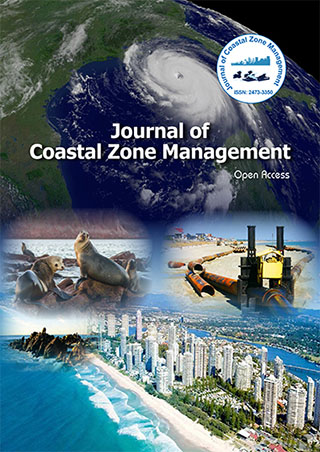Indexed In
- SafetyLit
- RefSeek
- Hamdard University
- EBSCO A-Z
- OCLC- WorldCat
- Publons
Useful Links
Share This Page
Journal Flyer

Open Access Journals
- Agri and Aquaculture
- Biochemistry
- Bioinformatics & Systems Biology
- Business & Management
- Chemistry
- Clinical Sciences
- Engineering
- Food & Nutrition
- General Science
- Genetics & Molecular Biology
- Immunology & Microbiology
- Medical Sciences
- Neuroscience & Psychology
- Nursing & Health Care
- Pharmaceutical Sciences
Perspective - (2024) Volume 27, Issue 4
Adapting Coastal Infrastructure to Rising Sea Levels: Innovative Engineering Solutions
Clara Pennington*Received: 03-Jul-2024, Manuscript No. JCZM-24-26303; Editor assigned: 05-Jul-2024, Pre QC No. JCZM-24-26303 (PQ); Reviewed: 19-Jul-2024, QC No. JCZM-24-26303; Revised: 26-Jul-2024, Manuscript No. JCZM-24-26303 (R); Published: 02-Aug-2024, DOI: 10.35248/2473-3350.24.27.632
Description
As global temperatures rise, sea levels are increasing at an alarming rate due to the melting of polar ice caps and the thermal expansion of seawater. This phenomenon poses a significant threat to coastal communities, infrastructure, and ecosystems. Adapting coastal infrastructure to rising sea levels is essential to mitigate the impacts of flooding, erosion, and storm surges. Innovative engineering solutions are significant for enhancing the resilience of coastal regions and ensuring their sustainable development.
Challenge and rising sea levels affect coastal infrastructure
Coastal areas are experiencing more frequent and severe flooding events. High tides, storm surges, and heavy rainfall exacerbate the risk of inundation, threatening homes, businesses, and critical infrastructure.
Erosion: Sea-level rise accelerates coastal erosion, leading to the loss of land and the weakening of natural and built structures. This erosion threatens the stability of roads, bridges, and buildings located near the shoreline.
Saltwater intrusion: Rising sea levels cause saltwater to intrude into freshwater aquifers, contaminating drinking water supplies and affecting agricultural productivity. This intrusion can also harm coastal ecosystems, including wetlands and estuaries.
Innovative engineering solutions
Seawalls are structures designed to protect the coastline from wave action and prevent erosion. Modern seawalls are built using durable materials such as concrete and steel, and they can be designed to absorb and dissipate wave energy.
Living shorelines use natural elements like marshes, mangroves, and oyster reefs to stabilize the coastline and absorb wave energy. These solutions enhance biodiversity, improve water quality, and provide habitat for marine life.
Elevating buildings on stilts or raised platforms protects them from flooding. This design is particularly effective for residential properties and essential facilities such as hospitals and schools.
Storm water management systems
Green roofs, permeable pavements, and rain gardens absorb and manage stormwater runoff, reducing the risk of urban flooding. These systems also provide environmental benefits, such as improved air quality and urban cooling.
Zoning regulations: Implementing zoning regulations that restrict development in high-risk areas can reduce vulnerability. Creating buffer zones and setback lines ensures that critical infrastructure is located away from the immediate threat of rising seas.
Challenges and considerations
Adapting coastal infrastructure is expensive, and securing funding for large-scale projects can be challenging. Governments, private sector stakeholders, and international organizations must collaborate to finance these initiatives.
Environmental impact: Engineering solutions must be designed to minimize negative environmental impacts. For instance, while seawalls protect against erosion, they can also disrupt natural sediment transport and harm marine ecosystems.
Policy and governance: Effective adaptation requires supportive policies and strong governance frameworks. Integrating climate adaptation into national and local planning, establishing clear regulatory standards, and promoting cross-sector collaboration are significant for success.
Adapting coastal infrastructure to rising sea levels is imperative for protecting coastal communities and sustaining economic development. Innovative engineering solutions, including seawalls, living shorelines, elevated structures, and resilient urban planning, approaches to address the challenges posed by sea-level rise. However, implementing these solutions requires significant investment, community engagement, and careful consideration of environmental impacts. By embracing adaptive and flexible strategies, we can enhance the resilience of coastal regions and safeguard them against the adverse effects of climate change.
Citation: Pennington C (2024) Impact of Climate Change on Coastal Ecosystems: Strategies for Adaptation and Resilience. J Coast Zone Manag. 27:632.
Copyright: © 2024 Pennington C. This is an open-access article distributed under the terms of the Creative Commons Attribution License, which permits unrestricted use, distribution, and reproduction in any medium, provided the original author and source are credited.
